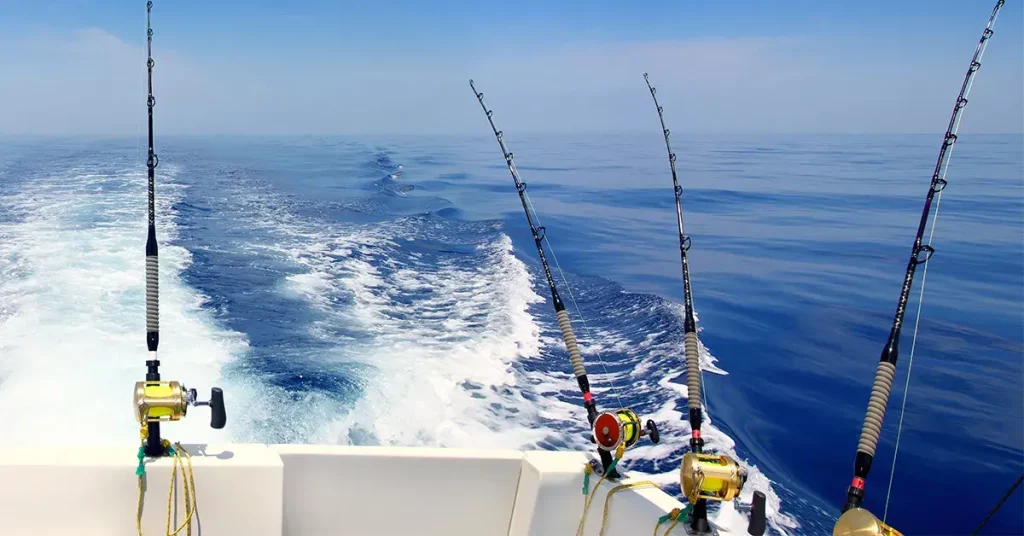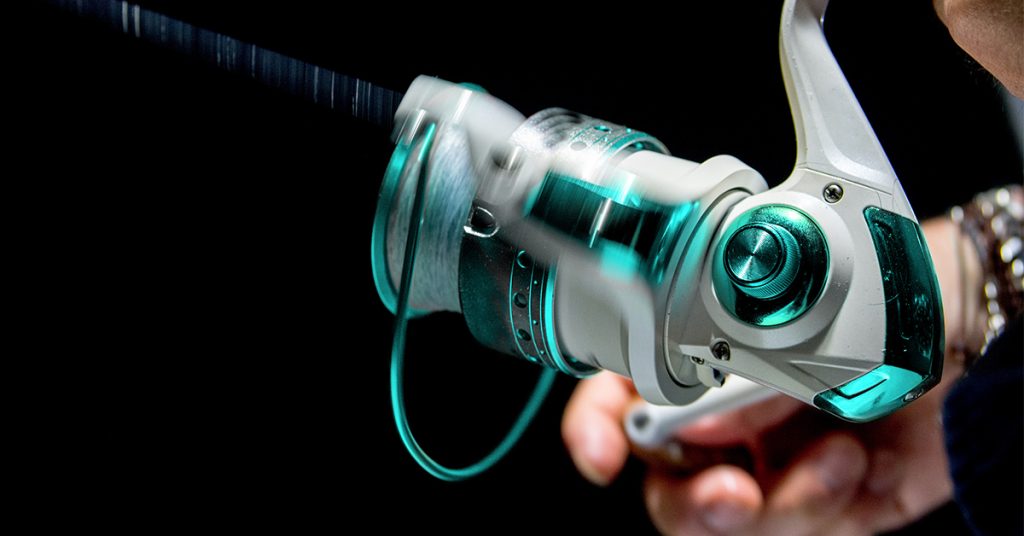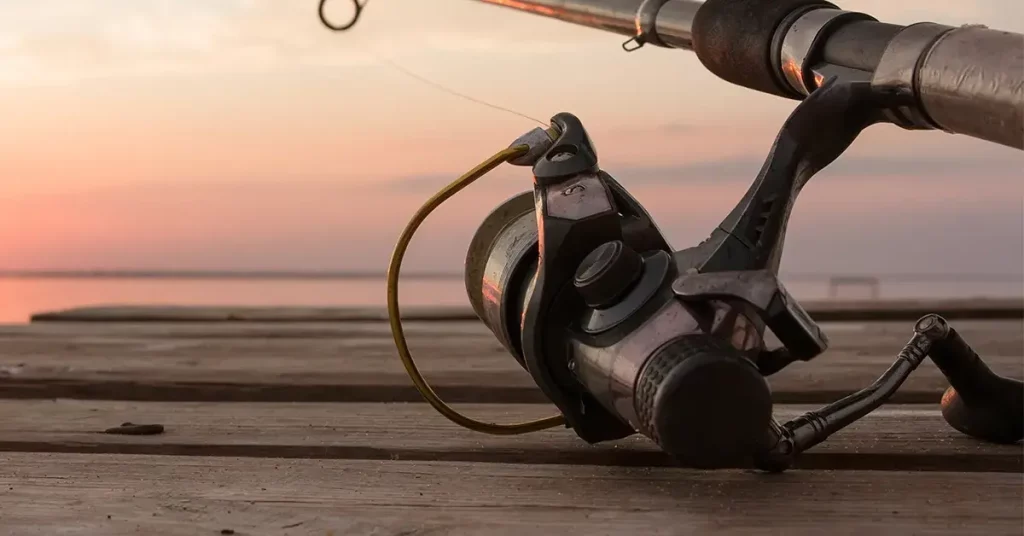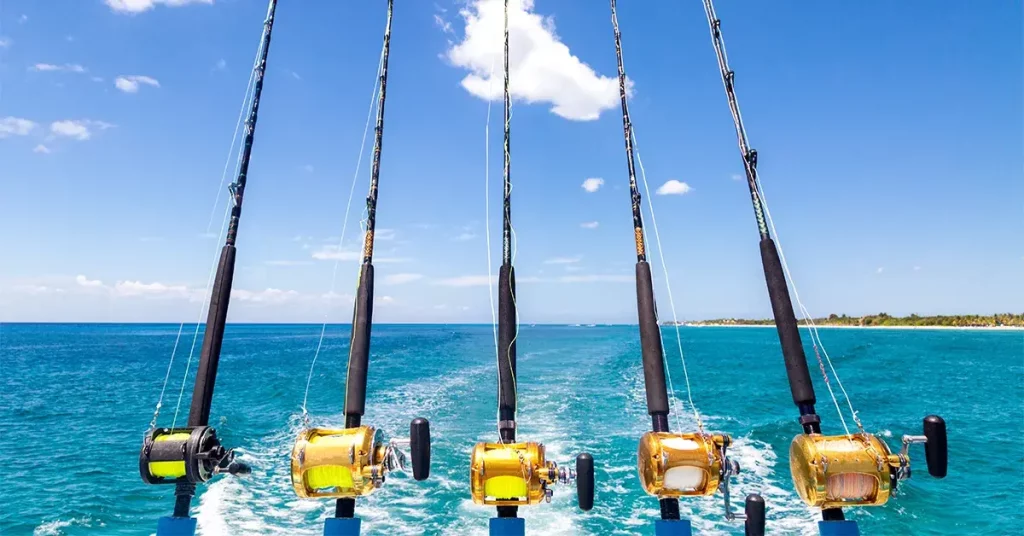Catching tuna is no joke. Tuna are strong, fast, put up one hell of a fight, and have the strength to snap inferior or mismatched rods into pieces. You’ll need a rod that’s flexible, durable, and strong enough to muscle a pissed off Yellowfin up from the depths.
That’s why spending the extra dough on a high-quality rod is well worth it. A good tuna rod should easily last 10+ years of regular use, plus most high-end rods come with lifetime warranties should anything go wrong.
Picking out the right tuna rod can be a challenging task. I’ll break down some of the best rods for each fishing technique, plus how to pick the best rod for your needs, budget, and preferences.
Quick Answer: 5 Best Tuna Rods
- Best Spinning Rod for Tuna: Shimano Trevala Spinning
- Best Tuna Casting Rod: Shimano Terez Saltwater Casting Rod
- Best Tuna Popping Rod: Jigging World Ghost Hunter Popping Rod
- Best Trolling/Heavy-Duty Rod: Blue Marlin Tournament Edition Trolling Rod
- Best Rod and Reel Combo: PENN Spinfisher V & VI Spinning Reel & Rod Combo
Best Spinning Rod for Tuna: Shimano Trevala Spinning
Perfect for pairing with fast and powerful reels, the Shimano Trevala spinning rods are ideally suited for jigging larger saltwater species. The Japanese style design is light and durable, weighing significantly less than traditional jigging rods.
A high carbon butt-section helps to cut down the overall weight, while the TC4 tip provides increased sensitivity and a lightning-fast recovery. Fuji aluminum oxide guides provide long-lasting durability and won’t wear down your line.
Available in a wide variety of lengths and power ratings, you can easily find the perfect model for your needs. For tuna fishing, the TVS60H or TVS66MH both make excellent options.
Pair the rod up with a fast and powerful reel like the Daiwa Saltist and you’ve got a deadly tuna slaying rig at a reasonable price.
EVA foam grips ensure you have a solid hold on the rod grip no matter how slippery the conditions get. Keep in mind that all of the rod configurations are one-piece, except for the two-piece TVS66MH2.
Key Features
- Lightweight and durable graphite construction
- Originally designed for fishing butterfly jigs, but works well for a variety of techniques
- Fuji guides provide long-lasting durability and line protection
View Pricing On:
Best Tuna Casting Rod: Shimano Terez Saltwater Casting Rod
If you’re looking for the latest and greatest in casting rods, look no further than the Shimano Terez series. These rods are surprisingly light and thin, utilizing the same composite TC4 construction found in the Trevala rods. They’re still tough-as-nails though – and capable of muscling monster 80 lb+ Tuna up from the depths.
Fuji K-series guides ensure your line won’t fray and prevent the possibility of wind knots developing. Skeletonized aluminum reel seats help to keep the rod weight down, while durable EVA grips provide a strong purchase on the rod.
The rod comes in several configurations – Medium Heavy through XX Heavy. The rods are between 6’6” and 7″ long, with fast or extra-fast actions – making them ideal for the quick response and solid hook-sets needed when tuna fishing.
Key Features
- Lightweight, compact rod with the pulling power of a much heavier pole
- Ideal for bait fishing, light trolling, and bottom fishing
- TC4 composite construction material allows for thin blanks that are tough-as-nails
View Pricing On:
Best Tuna Popping Rod: Jigging World Ghost Hunter Popping Rod
Throwing poppers and swimbaits are increasingly popular ways to target Tuna, and with good reason – they’re incredibly fun and deadly effective. These rods are designed specifically with the Tuna popping angler in mind.
Each model features a light blank with parabolic action, which transfers more torque to the hooked fish, helping wear it down and get it in the boat faster. Fuji components are used throughout the rod, from the Fuji MNAG guides to the Fuji DPS reel seat.
Four different rod configurations are available. From 100g to 300g lure weights, and max drag range between 15 and 40 pounds, you can easily find the ideal rod for your target fish. All rod configurations are 7’6” long two-piece rods with butt joint connections.
Pair one of these rods with a heavy-duty spinning reel like the SHIMANO SARAGOSA SW and you’ve got a deadly combo capable of taking down the most fearsome blue water predators.
Key Features
- Specifically designed with the Tuna popping angler in mind
- Parabolic action helps to wear down fish faster
- High-end Fuji components used for reel seat and guides
- Four different power ratings are available
Best Trolling/Heavy-Duty Rod: Blue Marlin Tournament Edition Trolling Rod
Rough, rugged, and built like a tank, this 3-piece deep-drop trolling rod is ideal for tackling Yellowfin Tuna, Marlin, trophy Wahoo, and other offshore giants. The 3.5-foot high-carbon composite blank features 4 wide-mouthed roller guards capable of passing the biggest wire leaders out there. They utilize spiral wrap construction, which prevents the rollers from twisting or warping under strain.
Both a bent butt and straight butt handle come included, which offers excellent versatility and flexibility. A swing tip guide moves the line effortlessly in the direction of the fish, preventing kinks and abrasion from developing.
The total rod length including the butt-end is just 5’ 5”, making it nearly indestructible. EVA foam grips provide a non-slip hold and comfort for prolonged battles.
This rod is designed to be paired with heavy-duty conventional reels like the Shimano Tiagra. With that combo you can use it for deep dropping, trolling or pulling large dredges.
Key Features
- Heavy-duty composite rod is ideal for trolling and other heavy-duty fishing
- Comes with both bent-butt and straight-butt handles
- Aluminum spiral rollers prevent warping or twisting
- Swing tip guides your line in any direction – preventing line abrasion
Best Rod and Reel Combo: PENN Spinfisher V & VI Spinning Reel & Rod Combo
If you’re looking for a rod and reel combo capable of taking down larger saltwater species, you’ll have a hard time beating this one – especially at this price point. Penn’s famous Spinfisher VI reel is paired up with a corresponding sized fiberglass rod to create an ideal offshore fishing rig.
For tuna and other large offshore species, the 7500-7′-Heavy and 8500-7′-Heavy models provide the right combination of power, toughness, and durability.
The Spinfisher reel is a true workhorse, with a full metal body and sideplates, PENN’s IPX5 sealed waterproofing, and a 5+1 sealed stainless steel ball-bearing system. The excellent HT-100 drag washers are made from carbon fiber.
The rod itself is all-fiberglass, with a tubular glass blank and a solid fiberglass tip – providing the muscle you need when tussling with offshore heavyweights. It’s 7’ long with a medium-heavy power and a fast action.
Rounding it all out are the EVA handle grips, which provide a solid hold on the rod no matter how much sea spray covers it.
Key Features
- Ideal rod and reel combo for tackling offshore and nearshore species
- 7500 and 8500 models are perfectly suited for Tuna fishing
- Renowned Spinfisher reel is a true workhorse
View Pricing On:
How to pick the best tuna rod for you
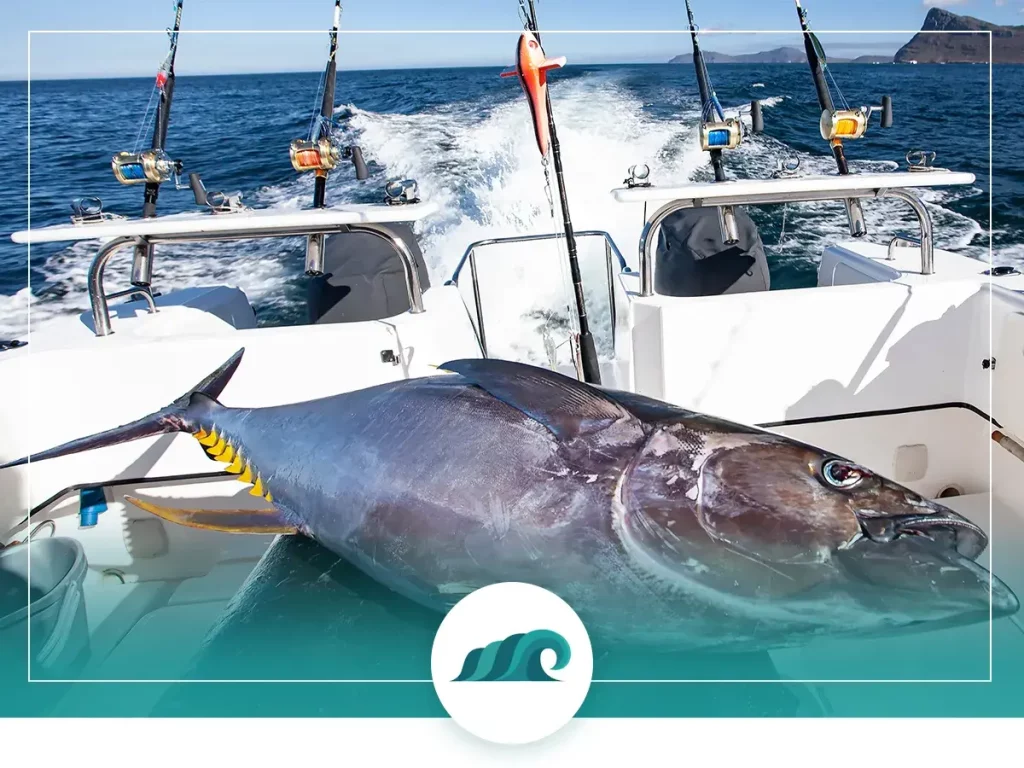
With so many options out there, picking the best tuna rod for your needs can seem like a herculean task. Not to worry – I’ll break down what you need to know before pulling the trigger on a new rod.
Fishing Technique
Your fishing technique will largely dictate the type of rod you’ll need.
Jigging rods are designed for dropping jigs deep into the water column. They should be relatively short and light – in the 5’8” to 6’6” range. You want to match the weight of your jig to the jigging rod’s intended jig weight. This will ensure the jig action works as intended – enticing the Tuna to bite with ferocity.
Both conventional and spinning setups work well for jigging, with spinning reels offering more finesse and sensitivity, while conventional tuna reels offer the muscle and drag needed to fight bigger fish.
Popping rods are specially designed for throwing poppers and swimbaits on the surface. These rods are typically longer – in the 7.5 to 8 foot range. The added length allows for the longer casts needed to drop a lure into a school of feeding tuna without getting too close.
These rods often feature lighter and parabolic blanks, which act to transfer more to torque to wear out the fish rather than the angler.
Popping rods are typically paired with spinning gear, but conventional tackle can also work.
Trolling rods vary widely depending on the Tuna species your targeting. They’re typically on the shorter side – measuring between 5’6” and 6’6”. They’re also generally on the heavier side, giving them the strength and backbone needed to pull spreader bars and dredges.
Trolling rods feature either roller guides or open guides depending on their weight class. Roller guides prevent excessive friction on your line when it’s under drag, which helps maintain line integrity and can help when fighting larger fish.
Materials
Rod materials have come along way over the last few years. Whereas not long ago the only rods capable of catching big tuna were big bulky broomstick looking things, newer rods utilize high-end composites to create slim, feather-light, and durable poles.
Fiberglass
Fiberglass is the most widely used material when it comes to tuna rods. It’s strong, durable, and flexible – and able to withstand the wear and tear that inevitably comes with heavy-duty offshore fishing.
The major downside of fiberglass is its weight. Fiberglass weighs significantly more than newer rod materials, making it more difficult to detect strikes – plus the added weight can tire you out in a prolonged fight.
Graphite
Graphite is lightweight, highly sensitive, and results in slim, smaller-diameter rods. These rods are ideal for detecting subtle strikes and really feeling the action and fish’s behavior.
The downside to graphite is its fragility. Compared to fiberglass, its fairly brittle, and can actually form nicks from rough use or from damage during transport. These nicks create weak spots in the rod, which will eventually fail under stress.
Composite
Increasingly popular among all types of saltwater anglers, composites combine the strength of fiberglass with the sensitivity and lightness of graphite.
Layered construction allows for highly advanced composites – like Shimano’s TC4 found in the Terez and Trevala series rods above. This composite results in a surprisingly slim diameter, while maintaining a high degree of toughness and durability.
Composites don’t have many downsides, other than price. Higher-end composites will cost significantly more than traditional fiberglass rods.
Butt Handle
This one comes down to personal preference and fishing style. Tuna rods are available with either bent-butt or straight-butt handles.
Bent butt handles are used when fishing with heavy drag settings on heavy tackle. They’re also generally used when fishing from a chair, to help to keep the rod tip down.
Straight butt handles are versatile and can be used for a wider variety of applications. Most people are familiar with using a straight butt rod, and they’re also easier to transport than bent butt rods.
In general, I’d recommend going with a straight butt, unless you’re planning on fishing from a fighting chair.
Price
When you’re talking Tuna gear, you’ll generally get what you pay for.
Shelling out the extra dough for a well-made composite rod will save you a lot of headaches down the line. If you’re not looking to splurge, you can still get a decent tuna stick in the $150 to $200 range, but don’t expect it to perform quite as well as more expensive options.
Once you start accumulating heavy-duty offshore rods and reels, you’ll probably want a good fishing rod rack to protect and display them.

